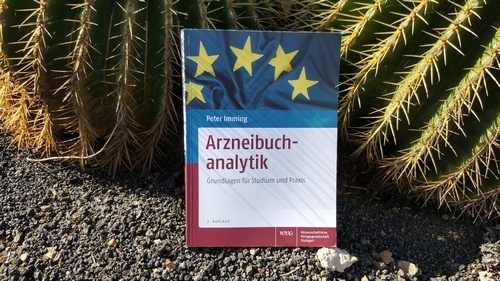Review of the book „Arzneibuchanalytik“ (compendial analytics)

Just like my last book review about drug dosage forms, this book has also been part of a vacation ????
In this blog article, I’d like to share my impressions of the book "Arzneibuchbuchanalytik" by Peter Imming (2nd edition, 2013, published in “wissenschaftliche Verlagsgesellschaft Stuttgart”, ISBN: 978-3-8047-2787-8).
The content
In terms of content, the book starts with regulatory basics that provides you with a good background for quality control of drugs. It is followed by an introduction about the main pharmacopoeias such as the European Pharmacopoeia (Ph. Eur) and the United States Pharmacopoeia (USP) and others, which makes you smile a bit. At this point it should be emphasized that the author knows how to write. He expresses with objectivity, if required, but sometimes also with very sympathetic charm and a good trace of humor and irony, which makes the reading very pleasant.
Following the analytical life of a drug (i.e. all stations where the drug undergoes analytical testing in course of its production, such as release testing) and the parameters of method validation according to the method validation guideline ICH Q2(R1) detailed chapters on several identity and content determination methods as well as titrations of the pharmacopoeia are presented, sometimes with a brief theoretical introduction.
This is followed by a chapter on fats and their analytical methods and often reference is made to food analysis, which brought back memories of my time as dairy lab technician trainee... Finally, a chapter about four very different monographs of the Ph. Eur. illustrates very well the diversity of the various monographs of the pharmacopoeias.
Pro's and Con's
As an educational book, the book is structured very well and didactically processed in a lovely manner. This includes check boxes that summarize the most important facts and small illustrative practice examples from time to time. Especially these examples facilitate reading and / or provide you with an understanding of the reason why which fact is important. A lot of illustrations and reaction schemes, a reference list as well as list of abbreviations and a German-English (and vice versa) vocabulary of the most important terms complete the book.
Altogether, the book is written in a very understandable way, but chemical knowledge (especially in organic chemistry) should be present. However, this should be expected from the target group for this book - pharmaceutical students in advanced study period...
But - personally - I was a little bit disappointed about the chapter on method validation. Of course, validation and verification were distinguished and all validation parameters such as trueness, precision, robustness, linearity, working range, limit of detection and quantitation as well as specificity were briefly explained. However, these were "only" the definitions and information of the validation guideline ICH Q2(R1). Due to my interest in validation of analytical methods, I would have liked to read more detailed information, critical explanations, own experiences or practical examples of the author. But this wish might have come from my strong personal interest in method validation and might go beyond the scope of such an educational book...
Conclusion
From the point of view of a non-pharmacist, this book seems to me to be a good educational book, which gives a first insight into compendial analysis and also well defines the most important aspects.
As with the last book, this book has also inspired me and provided some suggestions for individual additions to already written blog articles and some ideas for new posts. Above all, it has broadened my "think out of the box understanding" and refreshed some old chemistry skills ????
